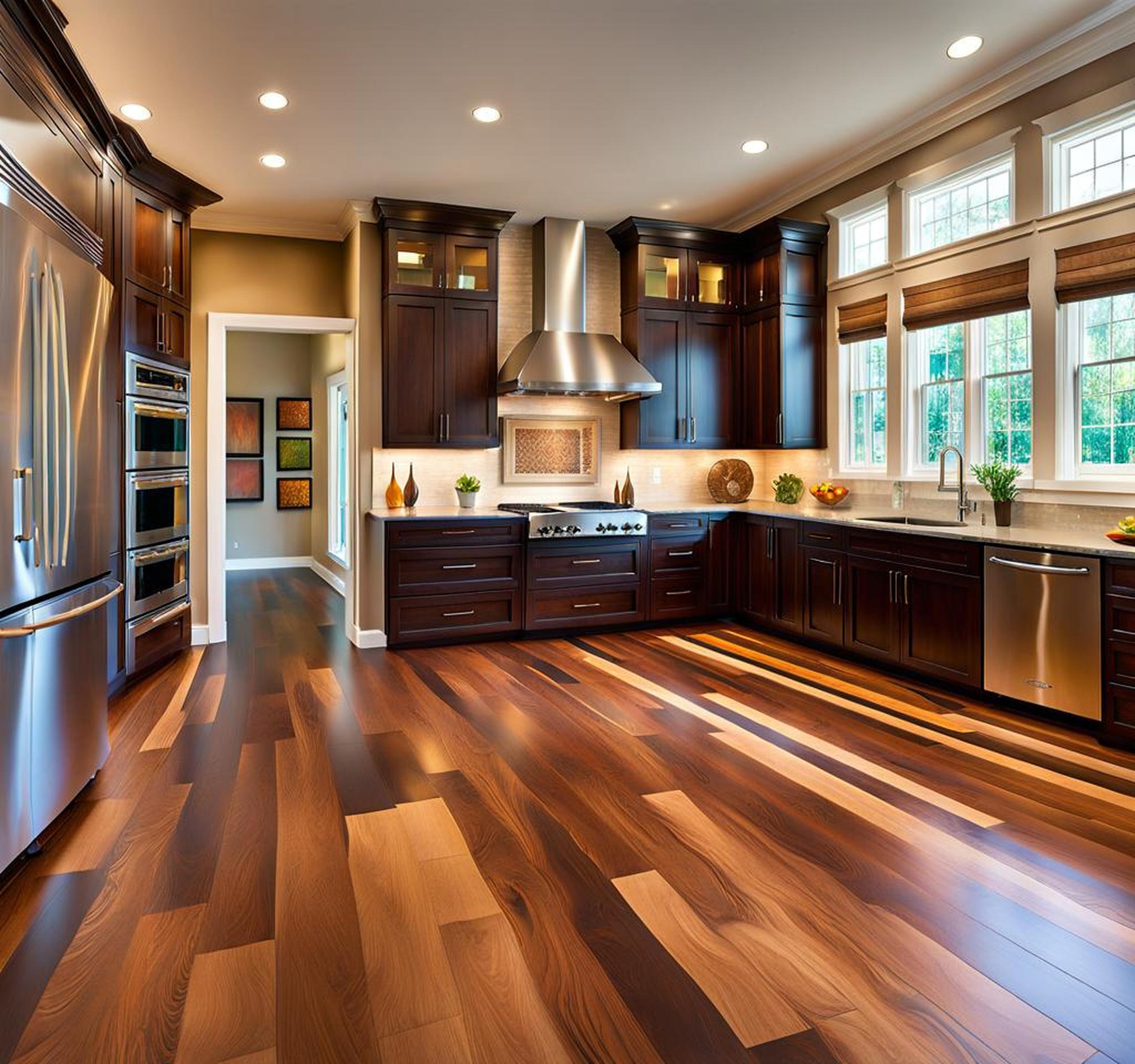Wood floors bring natural beauty and warmth wherever they’re installed. In living rooms, they make the space feel homey and cozy. In kitchens, wood can lend an elegant yet casual elegance that’s easy to clean. With so many benefits, it’s obvious why wood floors are popular choices for both kitchens and living room installations.
However, there are some key differences when selecting wood flooring for these distinct spaces. Factors like moisture resistance, durability, scratch protection and maintenance have to be weighed. The good news is that advancements in flooring technology now allow beautiful, high-performing wood floors in even the dampest kitchen settings.
Common Flooring Choices for Living Rooms vs. Kitchens
Favored Options for Living Spaces
In living rooms, the sky’s often the limit in terms of creative wood flooring options. Popular picks include:

- Solid hardwood from oak, maple, cherry or exotic species
- Engineered hardwood planks for added stability
- Luxury vinyl plank (LVP) mimicking real wood
Since living areas stay generally dry, almost any flooring type can work well. Decisions come down to factors like desired look, maintenance and budget.
Special Considerations for Kitchens
Kitchens demand a bit more strategic planning when selecting wood floors. Key considerations include:
- Moisture resistance: Spills and leaks are common, so waterproof protection is a must.
- Scratch protection: Pots, pans and pet nails can damage floors without durable finishes.
- Maintenance: Regular sweeping and steam mopping should keep floors looking their best.
- Costs: Budget-friendly options like vinyl plank may be best for high traffic kitchen spaces.
Key Differences Between Wood Flooring Types
Understanding the pros and cons of various wood flooring types allows smarter room-by-room selections.
Sleek and Strong: The Appeal of Solid Hardwood Floors
Solid hardwood flooring features thick planks milled from a single piece of wood lumber. This creates an elegantly expansive look showcasing the wood’s unique grain patterns and natural characteristics. Popular species like oak, hickory, maple and exotic hardwoods each make unique statements.
Benefits of solid wood include:
- Beautiful appearance with natural variations
- Can be repeatedly sanded and refinished
- Adds value for home resale
Downsides can include:
- Expensive upfront costs
- Not recommended for rooms with frequent moisture
- Susceptible to scratches and dents
Consistency and Stability: The Upside of Engineered Hardwood
If solid hardwood seems too temperamental, engineered wood floors bring more versatility. These modern floors feature plywood bases topped by hardy wood veneers for the look of solid wood with added durability.
Key engineered wood flooring advantages:
- More dimensionally stable
- Resists swelling and shrinkage
- Affordable option for kitchen installs
Potential downsides when compared to solid wood:
- Veneer layers are thinner
- Can’t be refinished as often
- Resale value not as high
Specialized Installation Factors
Proper installation tailored to each room’s needs gives wood floors the best chance of success.
Living Room Flooring Installation Essentials
Living room spaces give homeowners flexibility in terms of subflooring options, underlayment, and installation techniques. Key steps include:
- Ensuring subfloor is clean and even
- Selecting ideal underlayment thickness
- Choosing nail-down or floating floor method
Wide-plank solid floors installed over wood subfloors often achieve beautiful seamless looks in living rooms. Just be sure to leave sufficient expansion space at all edges.
Specialized Kitchen Flooring Installs
Kitchens have extra considerations due to heat, spills and high traffic. Recommended best practices include:
- Installing vapor barrier underlayment
- Using moisture-resistant bonding adhesives
- Incorporating flush transition strips between rooms
It’s smart to use an engineered hardwood floor rated for kitchen use rather than solid wood. Following manufacturer guidelines helps minimize issues.
Caring for Floors in Each Room
Investing in the right maintenance regimen keeps wood floors looking pristine while maximizing their usable lifespans.
Preserving Living Room Floors
Lighter foot traffic and dryness allows living room wood floors to shine for years when properly maintained. Tips include:
- Vacuuming then damp mopping regularly
- Applying protective floor wax 2-3 times per year
- Periodically polishing worn areas
- Putting felt pads under furniture legs
Refinishing or recoating solid hardwood every 5-10 years preserves its integrity through decades of use.
Protecting Kitchen Floors from Damage
Kitchen floors endure more wear and tear from heavy appliances, chair scrapes and food spills. Ways to preserve kitchen wood floors include:
- Sealing engineered planks annually
- Rotating washable area rugs
- Keeping humidity around 30-50% year-round
- Immediately cleaning up liquid spills
A bit of extra care keeps wood kitchen floors looking like new for over a decade or more.
Tying Spaces Together Stylishly
While engineered wood flooring often makes the most sense for kitchens, and solid floors better suit living rooms, it is possible to beautifully blend wood species and finishes between rooms. Tactics to create a cohesive style include:
- Repeating wood grains and tones
- Mixing wide and narrow plank widths
- Using consistent transition strips
- Adding coordinated area rugs
The flexibility of modern flooring materials makes it simple to play up contrast between rooms or achieve completely continuous flows.
One last consideration when comparing types of wood flooring is their cost. Here are typical price ranges for both materials and professional installation:
- Solid hardwood flooring – $5-13 per square foot for materials, $10+ per square foot installed
- Engineered hardwood flooring – $3-10 per square foot for materials only, $3-5 per square foot installed
- Luxury vinyl plank flooring – $2-5 per square foot for materials only, $3-4 per square foot installed
As you evaluate options for your home, factoring in longevity and maintenance costs beyond the initial price makes weighing options easier. With some smart planning, you can achieve perfect floors in both stylish and high-traffic zones.
